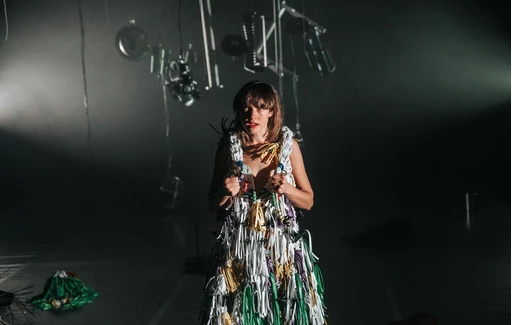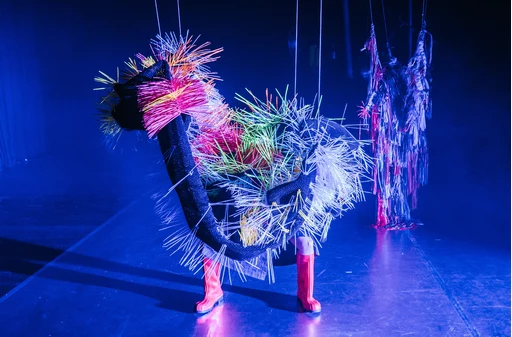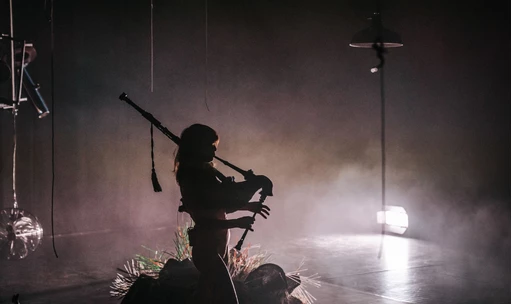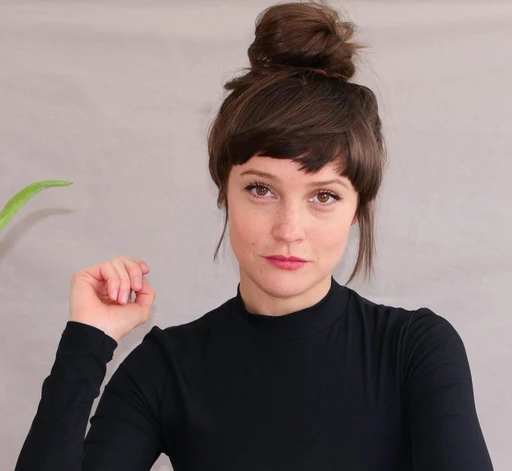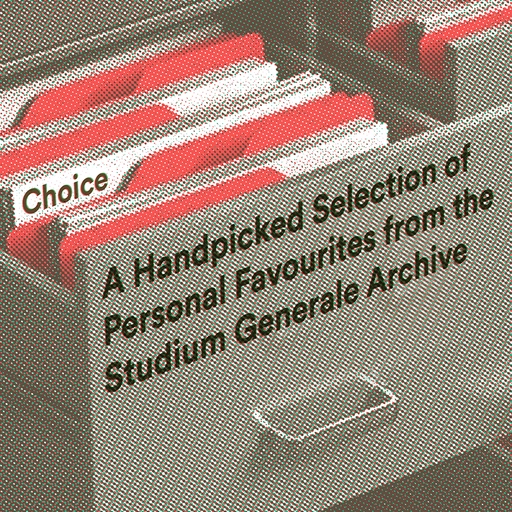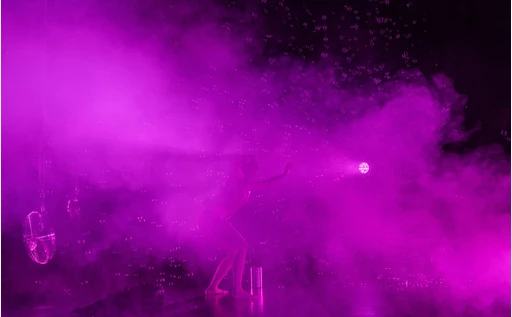
Since finishing her master studies Composition at the Royal Conservatory in The Hague, in 2013, Genevieve Murphy developed works that present sound and visuals in one, entangled unity. Her personal experiences melt into her work organically, like her experiences growing up with her autistic brother. The composer’s musical influences cross between contemporary classical, electronic pop, punk and free improvisation.
Genevieve often is composer, director and performer all-in-one. Over the last few years she collaborated with neurologist Erik Scherder, and she received the Nieuwe Maker subsidy from FPK with Nicole Beutler Projects, an organisation that continued to produce her work thereafter. For every new ‘performance composition’ she is starting from a blank canvas, radically finding, or inventing, the form that fits the subject.
In January 2023 she is part of the Winterlab Zwolle, leading the workshop ‘Sound You Can See and Art You Can Hear’. On this occasion, Studium Generale asked her to reflect on the meaning of the body and power(lessness) in her work, as part of our ongoing explorations of this theme.
Genevieve often is composer, director and performer all-in-one. Over the last few years she collaborated with neurologist Erik Scherder, and she received the Nieuwe Maker subsidy from FPK with Nicole Beutler Projects, an organisation that continued to produce her work thereafter. For every new ‘performance composition’ she is starting from a blank canvas, radically finding, or inventing, the form that fits the subject.
In January 2023 she is part of the Winterlab Zwolle, leading the workshop ‘Sound You Can See and Art You Can Hear’. On this occasion, Studium Generale asked her to reflect on the meaning of the body and power(lessness) in her work, as part of our ongoing explorations of this theme.
Quick Overview
I have a fascination for psychology and disability and integrate this into my compositions and performances. Including performative elements in my compositions for as long as I can remember, my research is focused on the physical and sonic link between sound and performance in a way that one cannot exist without the other. I have assigned musicians to speak, asked them to read concentration tests as scores, given durational performances and played intimate recordings of my family. Creating and performing solo productions as well as composing myself into ensemble works as a performer, musician and writer, my work is either autobiographical or shared from a personal perspective.
I have a fascination for psychology and disability and integrate this into my compositions and performances. Including performative elements in my compositions for as long as I can remember, my research is focused on the physical and sonic link between sound and performance in a way that one cannot exist without the other. I have assigned musicians to speak, asked them to read concentration tests as scores, given durational performances and played intimate recordings of my family. Creating and performing solo productions as well as composing myself into ensemble works as a performer, musician and writer, my work is either autobiographical or shared from a personal perspective.
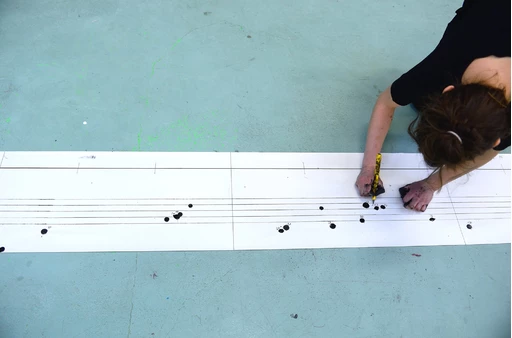

Personal connection to the theme ‘Body and Power(less)’
Physical sensations and thoughts have caused me to waver between states of empowerment and powerlessness. From a young age I have encountered challenges that continue to inspire me in my work today. I will share those works with you with the intention to demonstrate ways in which I avoid victimhood but rather share an acceptance towards vulnerability. The audience always has permission to laugh or cry in my work but my goal is to simply allow demanding states to be present without judgement or opinions arising in the piece itself.
Awareness Of The Power Of Music On The Body
Emotions are extremely abstract things and the beauty of music is that it can go straight into the body in a way that words cannot. Words go via the mind, to be processed and understood, whereas music can connect to a person physically before they can even understand what’s happening to them.
Around the age of seven I heard Annie Lennox' No More I Love You’s. I was in the car and it was on one of my brother’s complication tapes. I couldn’t believe music could sound like this. I was singing the beginning melody on top of all the other songs that came after it. I was amazed at how music could grab me like that and it was then that I realised the power of music and how it can transport the listener into another world.
I like to play with connection and disconnection through melody. I love the idea that my music can reach a person physically, not only stimulating their mind but also making their body move. I like to write catchy melodies that hook the listener into the music and at the same time steer them off into a direction that leaves the listener hanging in mid air. Through ambiguity there is a sensation of feeling unsure about where we are going and if we are in fact going anywhere. Music can build tension in such an incredible way, creating the sensation that something is about to happen next to feeling like we might never get there.
An individual’s perspective towards power and powerlessness
Alongside my own journey I grew up with an older brother who is autistic. This gave me a unique perspective on empathy and self-empowerment, from a young age. My sensitivity to the peculiar eccentricities that Ben needs in his daily life, for example, enabled me to develop an acute interest in what people need when they are unable to express themselves in words. For my brother eye contact, groups of people and physical contact such as hugging can be frightening. Music, rhythm, isolation and pressure on his body physically- such as climbing into a bed where the bed sheets are tightly tucked in around him at night- are extremely soothing and calm him down. Empathising with my brother’s behaviour, has sparked my inspiration in all of my works.
Squeeze Machine (2017) is specifically inspired by autism, looking into our similarities and differences within this subject. The fact that I do not fully connect to what my brother sees and hears has helped bring to my attention the fact that in us all, there is a discrepancy between what is happening inside our mind and body and what is happening on the outside. During Squeeze Machine it is as though we are in the company of someone with autism, who views the world visually and sensorily. I decided to use words and speech in this work, as though I were talking about my brother and at times being him. The result of my limited use of descriptive vocabulary in this piece should trigger the listener to fill in the details, creating their own individual visions while hearing music. I always express my personal perspective rather than claiming that I know how it feels to be autistic
In terms of the title, a squeeze machine was invented for autistic people who often struggle with physical contact. This machine puts pressure on the body, releasing endorphins, is soothing and makes one happy. Like an artificial hug. Its alternative name is a ‘hug machine’.
This work is not necessarily inspired by the mechanism itself, apart from at times working with a metallic timbre in the instrumentation. However, we seek comfort in a variety of ways. My brother for example, feels comfort in tight spaces and pressure on the body, I personally would find that distressing. I often try to seek a hug and though we would think of this as a basic human need, someone with autism may find this is distressing. With or without autism, we all share similar sensations as human beings. How we view and hear the world and what triggers us to be affected by it can be, however, very individual.
To me, music is another example of connecting externally to a person emotionally and physically, however, sound is also something very sensitive to a person with autism. My brother is very musical, this is something we have in common, so it feels appropriate for Artuur’s surrounding to be musical and sonically descriptive. Artuur, is from Germany and is the boy we follow through this composition.
Physical sensations and thoughts have caused me to waver between states of empowerment and powerlessness. From a young age I have encountered challenges that continue to inspire me in my work today. I will share those works with you with the intention to demonstrate ways in which I avoid victimhood but rather share an acceptance towards vulnerability. The audience always has permission to laugh or cry in my work but my goal is to simply allow demanding states to be present without judgement or opinions arising in the piece itself.
Awareness Of The Power Of Music On The Body
Emotions are extremely abstract things and the beauty of music is that it can go straight into the body in a way that words cannot. Words go via the mind, to be processed and understood, whereas music can connect to a person physically before they can even understand what’s happening to them.
Around the age of seven I heard Annie Lennox' No More I Love You’s. I was in the car and it was on one of my brother’s complication tapes. I couldn’t believe music could sound like this. I was singing the beginning melody on top of all the other songs that came after it. I was amazed at how music could grab me like that and it was then that I realised the power of music and how it can transport the listener into another world.
I like to play with connection and disconnection through melody. I love the idea that my music can reach a person physically, not only stimulating their mind but also making their body move. I like to write catchy melodies that hook the listener into the music and at the same time steer them off into a direction that leaves the listener hanging in mid air. Through ambiguity there is a sensation of feeling unsure about where we are going and if we are in fact going anywhere. Music can build tension in such an incredible way, creating the sensation that something is about to happen next to feeling like we might never get there.
An individual’s perspective towards power and powerlessness
Alongside my own journey I grew up with an older brother who is autistic. This gave me a unique perspective on empathy and self-empowerment, from a young age. My sensitivity to the peculiar eccentricities that Ben needs in his daily life, for example, enabled me to develop an acute interest in what people need when they are unable to express themselves in words. For my brother eye contact, groups of people and physical contact such as hugging can be frightening. Music, rhythm, isolation and pressure on his body physically- such as climbing into a bed where the bed sheets are tightly tucked in around him at night- are extremely soothing and calm him down. Empathising with my brother’s behaviour, has sparked my inspiration in all of my works.
Squeeze Machine (2017) is specifically inspired by autism, looking into our similarities and differences within this subject. The fact that I do not fully connect to what my brother sees and hears has helped bring to my attention the fact that in us all, there is a discrepancy between what is happening inside our mind and body and what is happening on the outside. During Squeeze Machine it is as though we are in the company of someone with autism, who views the world visually and sensorily. I decided to use words and speech in this work, as though I were talking about my brother and at times being him. The result of my limited use of descriptive vocabulary in this piece should trigger the listener to fill in the details, creating their own individual visions while hearing music. I always express my personal perspective rather than claiming that I know how it feels to be autistic
In terms of the title, a squeeze machine was invented for autistic people who often struggle with physical contact. This machine puts pressure on the body, releasing endorphins, is soothing and makes one happy. Like an artificial hug. Its alternative name is a ‘hug machine’.
This work is not necessarily inspired by the mechanism itself, apart from at times working with a metallic timbre in the instrumentation. However, we seek comfort in a variety of ways. My brother for example, feels comfort in tight spaces and pressure on the body, I personally would find that distressing. I often try to seek a hug and though we would think of this as a basic human need, someone with autism may find this is distressing. With or without autism, we all share similar sensations as human beings. How we view and hear the world and what triggers us to be affected by it can be, however, very individual.
To me, music is another example of connecting externally to a person emotionally and physically, however, sound is also something very sensitive to a person with autism. My brother is very musical, this is something we have in common, so it feels appropriate for Artuur’s surrounding to be musical and sonically descriptive. Artuur, is from Germany and is the boy we follow through this composition.
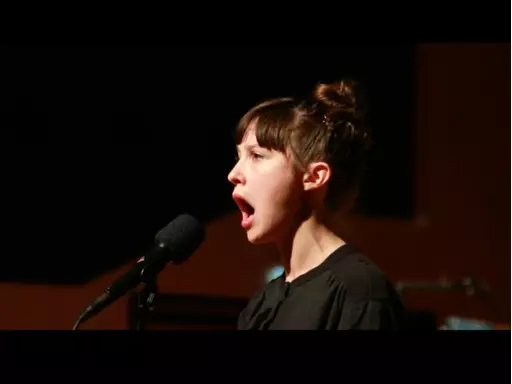

When I started this work, I was fascinated by our mouths, that it consumes, takes, owns, tastes and can express, represent volume of sound and expression. Many people with autism have a difficulty speaking, as though they are ‘drowning in a flood of words’ (Higashida, 2014).
In a state of desperation, Ben sometimes opens his mouth and a roar of emotion from the tips of his toes to, up through his body, the finger tips, the shoulders, skimming past the tips of his teeth. It would hit our head, fire down, through our shoulders, chests, fingers, knees, toes and into the ground.
However, Ben also bursts into laughter, able to see things we cannot see. When he laughs, it sounds like a drain, where all trouble gets washed away and we all get sucked in to laughing along, having no idea what at but feeling inspired by humour and it’s strength that keeps us in the present, without feeling the importance of making sense.
I started to combine observations and gestures that I identify with Ben.
In a state of desperation, Ben sometimes opens his mouth and a roar of emotion from the tips of his toes to, up through his body, the finger tips, the shoulders, skimming past the tips of his teeth. It would hit our head, fire down, through our shoulders, chests, fingers, knees, toes and into the ground.
However, Ben also bursts into laughter, able to see things we cannot see. When he laughs, it sounds like a drain, where all trouble gets washed away and we all get sucked in to laughing along, having no idea what at but feeling inspired by humour and it’s strength that keeps us in the present, without feeling the importance of making sense.
I started to combine observations and gestures that I identify with Ben.
Powerless In Society
Personally, presenting art is an opportunity for me to communicate specific subjects and to raise awareness. It seems clear that in society, trust and understanding towards learning disabilities, mental health and other health conditions still needs to be developed further. For example, being a performer who is sharing subjects around mental health, I am often met with the response that I do not behave hysterical enough. There is a strange stereotype where a person who starts to loose sense of reality should then react by waving their arms around, talking to themselves, shouting and losing control over their body. It’s possible that this applies to women especially. However this is not necessarily the case and problems become ignored because they seem ‘in control’ while their world crumbles around them. I therefore try to show that conflict between control (or the appearance of) and the tipping point into destruction (towards themselves or surroundings).
As for autism ÷ my brother has been one of my biggest inspirations growing up but I am aware that many people do not cross paths with autism and its complexity.
‘Squeeze Machine’was also inspired by the book The Reason I Jump, by Naoki Higashida, a non-verbal teenager with autism explaining the reasons behind his behaviours and bringing an empowering perspective on autism.
I think that people with autism are born outside the regime of civilisation. Sure, this is just my own made-up theory, but I think that, as a result of all the killings in the world and selfish planet-wrecking that humanity has committed, a deep sense of crisis exists.
Autism has somehow arisen out of this. Although people with autism look like other people physically, we are in fact very different in many ways. We are more like travellers from the distant past. And if, by our being here, we could help the people of the world remember what truly matters for the Earth, that would give us a quiet pleasure. (Higashida, 2014)
Personally, presenting art is an opportunity for me to communicate specific subjects and to raise awareness. It seems clear that in society, trust and understanding towards learning disabilities, mental health and other health conditions still needs to be developed further. For example, being a performer who is sharing subjects around mental health, I am often met with the response that I do not behave hysterical enough. There is a strange stereotype where a person who starts to loose sense of reality should then react by waving their arms around, talking to themselves, shouting and losing control over their body. It’s possible that this applies to women especially. However this is not necessarily the case and problems become ignored because they seem ‘in control’ while their world crumbles around them. I therefore try to show that conflict between control (or the appearance of) and the tipping point into destruction (towards themselves or surroundings).
As for autism ÷ my brother has been one of my biggest inspirations growing up but I am aware that many people do not cross paths with autism and its complexity.
‘Squeeze Machine’was also inspired by the book The Reason I Jump, by Naoki Higashida, a non-verbal teenager with autism explaining the reasons behind his behaviours and bringing an empowering perspective on autism.
I think that people with autism are born outside the regime of civilisation. Sure, this is just my own made-up theory, but I think that, as a result of all the killings in the world and selfish planet-wrecking that humanity has committed, a deep sense of crisis exists.
Autism has somehow arisen out of this. Although people with autism look like other people physically, we are in fact very different in many ways. We are more like travellers from the distant past. And if, by our being here, we could help the people of the world remember what truly matters for the Earth, that would give us a quiet pleasure. (Higashida, 2014)
Control - A Challenging Balance Between Power and Powerlessness
‘Tubes vomiting colour; machines taking the lead; blue foam leaking out of corners; an orchestra trapped in words: in the carefully composed works of Genevieve Murphy there is always space for the unleashing of control. In her worlds, in which an undue desire for control dominates throughout, these extremely satisfying releases are not just fun: the thrill that comes from releasing the strings that hold everything together is a vital necessity.’ (Scholts, 2019)
‘Tubes vomiting colour; machines taking the lead; blue foam leaking out of corners; an orchestra trapped in words: in the carefully composed works of Genevieve Murphy there is always space for the unleashing of control. In her worlds, in which an undue desire for control dominates throughout, these extremely satisfying releases are not just fun: the thrill that comes from releasing the strings that hold everything together is a vital necessity.’ (Scholts, 2019)
Created, built and performed by Genevieve Murphy.
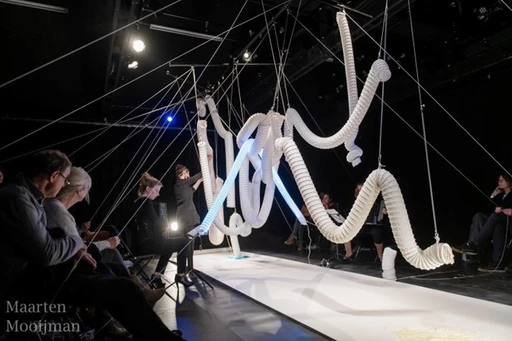

At the core of all of my works is the subject of ‘control’ and therefore in my earlier work I include liquid as a material. For example - when thinking of ‘perfection’ as a symptom of keeping control, if one were to fill a sink perfectly, they’d fill it to the brim, but one more drop and the sink will overflow.
Many symptoms arise when striving for ‘ultimate control’ and those symptoms are portrayed in many of my works. Specific themes that have travelled through my work to mention but a few: self destruction, compulsive obsessive disorder, fear and anxiety, perfectionism.
Many symptoms arise when striving for ‘ultimate control’ and those symptoms are portrayed in many of my works. Specific themes that have travelled through my work to mention but a few: self destruction, compulsive obsessive disorder, fear and anxiety, perfectionism.
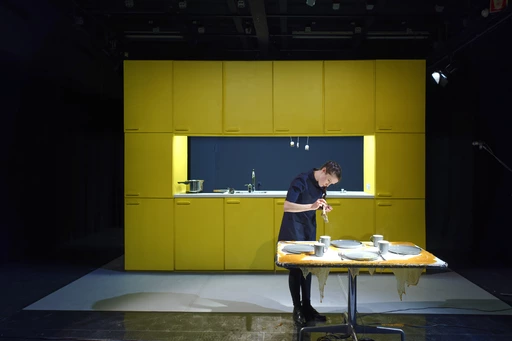

Something In This Universe is a solo performance I created and performed in, questioning whether there is such a thing as isolation when comforted by an infinite desire for perfection. Inspired by the ‘tipping point’ between control and destruction we view a person captured between the seduction and obsession of a compulsive disorder.
Trailer Genevieve Murphy: Something In This Universe
My Body and Power(lessness)
My latest work At The Spot Where I Find Myselfis possibly the most vulnerable and (personally) empowering work I have created for myself - physically speaking. On the one hand I am a theatrical body and on the other I put my body in the centre of this piece triggering the question for the audience, ‘Is this me or not?’
The piece is about a woman who is stuck in a position of indecision - unable to feel that she is at the spot where she finds herself - and as a result becomes increasingly aware of her body in the space, observing her apartment as an extension of herself. I like to think of people expressing their emotions in their homes, our washing machine, sofa, bed, walls etc. are like diaries absorbing our reactions to life. Provoking us to view our own places of safety where we can release emotions, find protection and hide, I form an alliance with the audience in the private space on stage that I call ‘home’. During the performance I project into the objects on stage, speaking as the sofa, lamp, soap which then share my stories and reveal certain states that they’ve witnessed.
Half way through, as a result of absorbing the thoughts from the household objects I remove my clothes and am naked while performing as others. The conflict of power and powerlessness is portrayed through opening up, expressing myself in a liberated way while being naked yet still avoiding who I really am by embodying the objects around the house.
My latest work At The Spot Where I Find Myselfis possibly the most vulnerable and (personally) empowering work I have created for myself - physically speaking. On the one hand I am a theatrical body and on the other I put my body in the centre of this piece triggering the question for the audience, ‘Is this me or not?’
The piece is about a woman who is stuck in a position of indecision - unable to feel that she is at the spot where she finds herself - and as a result becomes increasingly aware of her body in the space, observing her apartment as an extension of herself. I like to think of people expressing their emotions in their homes, our washing machine, sofa, bed, walls etc. are like diaries absorbing our reactions to life. Provoking us to view our own places of safety where we can release emotions, find protection and hide, I form an alliance with the audience in the private space on stage that I call ‘home’. During the performance I project into the objects on stage, speaking as the sofa, lamp, soap which then share my stories and reveal certain states that they’ve witnessed.
Half way through, as a result of absorbing the thoughts from the household objects I remove my clothes and am naked while performing as others. The conflict of power and powerlessness is portrayed through opening up, expressing myself in a liberated way while being naked yet still avoiding who I really am by embodying the objects around the house.
At The Spot Where I Find Myself by Genevieve Murphy 2022
By wearing the sofa and bedroom I end up carrying around 45kg and subsequently turn myself into a strange creature crawling around on the floor. I then manage to stand up and wear the costume like a dress and coat before fighting with the material until I am released from it.
Rather than solving my feeling of lostness and indecision I embrace it, standing in front of the audience, naked, saying, ‘The darkness helps to join us together.’ and ‘Breath and air embrace this entire universe,’ before blowing into the bagpipes which are tremendously loud and powerful, requiring my full strength.
This ending is almost an attack on the audience but channels and releases the tension that has been building through the performance. The performer never really does arrive at the spot where she finds herself, this will be an ongoing search.
Rather than solving my feeling of lostness and indecision I embrace it, standing in front of the audience, naked, saying, ‘The darkness helps to join us together.’ and ‘Breath and air embrace this entire universe,’ before blowing into the bagpipes which are tremendously loud and powerful, requiring my full strength.
This ending is almost an attack on the audience but channels and releases the tension that has been building through the performance. The performer never really does arrive at the spot where she finds herself, this will be an ongoing search.
Literature
Naoki Higashida, The Reason I Jump, 2014
Nienke Scholts, About the artist, 'The Physical World Is Far More Dazzling Than This'. Website Genevieve Murphy, opened on 23 January 2023
In 2020 Mister Motley published an interview with Genevieve Murphy by Sophie Smeets. You can find that here (in Dutch): Mijn werk gaat niet over mij. Gesprek met Genevieve Murphy.
Naoki Higashida, The Reason I Jump, 2014
Nienke Scholts, About the artist, 'The Physical World Is Far More Dazzling Than This'. Website Genevieve Murphy, opened on 23 January 2023
In 2020 Mister Motley published an interview with Genevieve Murphy by Sophie Smeets. You can find that here (in Dutch): Mijn werk gaat niet over mij. Gesprek met Genevieve Murphy.
refered to from:
people – 23 jan. 2023
Genevieve Murphy
blog – 03 apr. 2024
